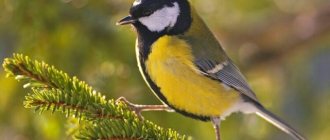Lesson summary "Titmouse's Day"
Lyakhova Kristina Yurievna
Lesson summary "Titmouse's Day"
fostering a caring attitude and interest in wintering birds; development of children's attention, the ability to correlate changes in nature with the life of wintering birds.
1. Expand knowledge about the role of birds in nature and human life.
2. Teach to recognize birds by their characteristic features.
3. To instill in children a caring attitude towards nature and a desire to help birds in difficult winter conditions.
4. Develop independence and communication skills of working in a team.
5. Develop the ability to compare and identify distinctive features.
6. Develop children's creative abilities.
Autumn is nearing its end. The last month of autumn has arrived. For a long time in Russia, November 12 was celebrated as Titmouse Day , i.e., the day of meeting of wintering birds. People prepared feeders, read poems about birds, asked riddles, played and simply admired the winter birds.
For several years in a row, this day in our country has been celebrated as the Day of Meeting of Wintering Birds, when you can hang out feeders and start feeding birds.
Tits often fly to balconies and peck food wrapped in paper. They love unsalted lard. In winter, it is difficult for tits to find food “canteens” for them.
. Pieces of lard can also be tied to the feeder where dry rations are poured.
Now let's move on to the quiz questions.
1st round (questions are asked to each team in turn)
—Which bird is considered a symbol of wisdom and knowledge? (owl)
— Who is called the forest doctor? (woodpecker)
-What bird can count the years of our lives? (cuckoo)
-Which bird flies the farthest and highest? (eagle)
2nd round (questions are asked to each team in turn)
1. What bird flies to us with the onset of winter and likes to eat rowan? (bullfinch)
3. Which bird’s tail helps not only in flight, but also in getting food? (woodpecker)
4. What bird does not build nests and hatch chicks? (cuckoo)
5. An agile and dexterous bird with a greenish back and yellow belly. ( tit )
6. This bird makes its nests in cliffs above the river. (martin)
8. What bird is called a nocturnal cat? (to the owl)
3rd round (questions are asked to each team in turn)
1. What birds come to us first in the spring? (Rooks.)
2. Which bird of our forests best imitates bird voices? (Starling)
3. Bird's hands. (Wings.)
5. Which bird has a very long tail? (Magpie)
6. Which bird is called the “forest doctor”
?
(woodpecker)
7. What bird doesn’t build a nest? (cuckoo)
Conversation with children “Titmouse Day”
Elizaveta Arapova
Conversation with children “Titmouse Day”
Meeting with children on the topic : “ Sinichkin Day ”
.
The purpose of the conversation : to form in children a general idea of tits , their benefits to humans, and the peculiarities of their appearance and behavior.
1) learn to distinguish tits from other species of birds,
2) cultivate a caring attitude and interest in wintering birds,
3) create a desire to help birds in winter.
Educational areas: cognition, communication, socialization, reading fiction.
Preliminary work: observing while walking birds. Reading fiction. Listening to V. Bianchi’s story “ Sinichkin’s calendar ”
. Looking at illustrations of birds.
Equipment: subject pictures depicting wintering birds.
People noticed that in late autumn - November 12, birds gather in flocks. It’s as if these colorful and elegant birds flock to a holiday. In the old days, November 12th
.
Therefore, this particular day is considered the day of meeting of wintering birds. There are many memorable days and holidays in Rus'. Titmouse based on the Russian folk holiday Zinovy the Titmouse , which is named in memory of the holy Great Martyr Zinovy, patron of wintering birds.
It is believed that it is on this day , November 12, that birds from the forests fly to villages and cities. For the winter.
Among the people there are signs associated with the titmouse holiday .
1. If tits , it means the first frosts will hit soon.
2. If wolves appeared in the fields on this day , then this foreshadowed famine or war.
You ask: “Why are birds called tits? ”
?
This is a small bird (its weight is 20 grams and its length is 15 cm.)
.
She's been busy all long summer : she needs to feed the hungry chicks. The tit has about 15 of them , and they hatch twice a summer. So the bird flies all day long in search of food . He will find a worm for the children too. In a day , a tit eats as many insects as it weighs.
The tit row is extensive . 6 species of these birds live in our parks and forests. In autumn and winter, all of them can be seen in the city at the feeders . On a sunny afternoon they sing their song loudly and drawn out: blue-blue, but it seems to us: “Take off your caftan.”
.
Did you know that in winter our feathered friends get cold and hungry? Out of 10 tits, only 1 survives until spring. And our task is to prevent our wintering birds from dying of hunger in the winter, make feeders for them and feed the birds in the winter.
From Titmouse Day , with the arrival of the first cold weather, it was customary to feed the birds and take care of them. People said: “Feed the birds in winter, they will serve you in the spring.”
.
On this day , people install feeders on trees, scatter seeds and grains, and hang pieces of lard outside the window. In winter, in the absence of insects, tits eat everything - not only lard, but also sunflower seeds, cereals, and plant seeds.
Millet and millet are the favorite food of buntings and sparrows. Rowan and viburnum berries are the favorite food of bullfinches and waxwings. It is better to harvest after the first frost. Bread crumbs, leftover flour and meat products can also be given to birds.
Raw lard is an excellent food for tits , nuthatches and woodpeckers. Pieces of unsalted lard are hung on strings.
Source
Entertainment script “Titmouse’s Day”
Maria Smirnova
Entertainment script “Titmouse’s Day”
Entertainment " Sinichkin's holiday "
Goal: to clarify and expand children’s understanding of wintering birds.
• Introduce children to wintering birds.
• Develop attention in children
• Foster a caring attitude and interest in wintering birds.
• Develop the ability to correlate changes in nature with the life of wintering birds.
Equipment: Pictures of birds, CD with music.
Lesson summary "Titmouse's Day"
Olga Sidorova
Lesson summary "Titmouse's Day"
Lesson summary " Titmouse's Day "
.
• to form in children a general idea of tits , their benefits for humans,
features of their appearance and behavior.
• introduce children to the tit and the holiday “ Titmouse Day ”
• learn to distinguish tits from other bird species
• cultivate a kind, caring attitude towards nature, develop an interest in the life of birds.
Material and equipment:
• ICT, audio recordings, pencils, coloring books, object pictures.

